Advertisements
Advertisements
Question
Consider the situation shown in figure. The plates of the capacitor have plate area A and are clamped in the laboratory. The dielectric slab is released from rest with a length a inside the capacitor. Neglecting any effect of friction or gravity, show that the slab will execute periodic motion and find its time period.
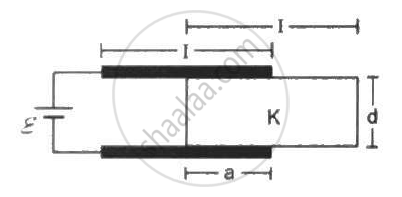
Solution
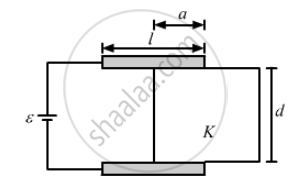
Given that the area of the plates of the capacitors is A.
As ''a'' length of the dielecric slab is inside the capacitor.
Therefore, the area of the plate covered with dielectric is `= A/la`
The capacitance of the portion with dielectric is given by `C_1 = (K∈_0Aa)/(ld)`
The capacitance of the portion without dielectric is given by `C_1 = (∈_0A(l-a))/(ld)`
The two parts can be considered to be in parallel.
Therefore, the net capacitance is given by
`C = C_1 + C_2`
`⇒ C = (∈_0A)/(ld)[Ka + (l-a)]`
`⇒ C = (∈_0A)/(ld)[l + a(K-1)]`
Let us consider a small displacement da of the slab in the inward direction. The capacitance will increase, therefore the energy of the capacitor will also increase. In order to maintain constant voltage, the battery will supply extra charges, therefore the battery will do work.
Work done by the battery = change in energy of capacitor + work done by the force F on the capacitor
`dW_B = dU + dW_F`
Let the charge dq is supplied by the battery, and the change in the capacitor be dC
`dW_B = (dq).V = (dC).V^2`
`dU = 1/2(dC).V^2`
`(dC).V^2 = 1/2(dC).V^2 + F.da`
`1/2(dC).V^2 = F.da`
`⇒ F = 1/2 (dC)/(da)V^2`
`⇒ F = 1/2 d/(da) ((∈_0A)/(ld)[l + a(K-1)])V^2`
`⇒ F = 1/2 (∈_0A)/(ld) (K - 1)`
The acceleration of the dielectric is given by `a_0 = 1/2 (∈_0A)/(ldm)(K-1)`
As, the force is in inward direction, it will tend to make the dielectric to completely fill the space inside the capacitors. As, the dielectric completely fills the space inside the capacitor at this instant its velocity is not zero. The dielectric slab tends to move outside the capacitor. As the slab tends to move out, the direction of the force due to the capacitor will reverse its direction. Thus, the dielectric slab will have a periodic motion.
The time taken to move distance `(l-a)` can be calculated as :-
`(l - a) = 1/2 a_0t^2`
`t = sqrt ((2(l-a))/(a_0))`
`t = sqrt (2(l-a) xx (2ldm)/(∈_0AV^2(K-1))`
`t = sqrt ((4m(l-a)ld)/(∈_0AV^2(K-1))`
For the complete cycle the time period will be four times the time taken for covering distance `(l-a)`.
It is given by :-
`T = 4t = 4 xx 2 sqrt((m(l-a)ld)/(∈_0AV^2(K-1))) = 8 sqrt ((m(l-a)ld)/(∈_0AV^2(K-1))`
APPEARS IN
RELATED QUESTIONS
When an AC source is connected to an ideal capacitor, show that the average power supplied by the source over a complete cycle is zero
Find the equivalent capacitance of the network shown in the figure, when each capacitor is of 1 μF. When the ends X and Y are connected to a 6 V battery, find out (i) the charge and (ii) the energy stored in the network.

A spherical capacitor has an inner sphere of radius 12 cm and an outer sphere of radius 13 cm. The outer sphere is earthed and the inner sphere is given a charge of 2.5 µC. The space between the concentric spheres is filled with a liquid of dielectric constant 32.
(a) Determine the capacitance of the capacitor.
(b) What is the potential of the inner sphere?
(c) Compare the capacitance of this capacitor with that of an isolated sphere of radius 12 cm. Explain why the latter is much smaller.
Two identical capacitors of 12 pF each are connected in series across a battery of 50 V. How much electrostatic energy is stored in the combination? If these were connected in parallel across the same battery, how much energy will be stored in the combination now?
Also find the charge drawn from the battery in each case.
A capacitor of unknown capacitance is connected across a battery of V volts. The charge stored in it is 300 μC. When potential across the capacitor is reduced by 100 V, the charge stored in it becomes 100 μC. Calculate The potential V and the unknown capacitance. What will be the charge stored in the capacitor if the voltage applied had increased by 100 V?
Three identical capacitors C1, C2 and C3 of capacitance 6 μF each are connected to a 12 V battery as shown.
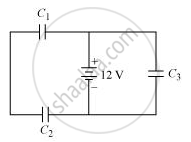
Find
(i) charge on each capacitor
(ii) equivalent capacitance of the network
(iii) energy stored in the network of capacitors
A capacitor has capacitance C. Is this information sufficient to know what maximum charge the capacitor can contain? If yes, what is this charges? If no, what other information is needed?
A capacitor of capacitance C is charged to a potential V. The flux of the electric field through a closed surface enclosing the capacitor is
Find the charge appearing on each of the three capacitors shown in figure .

Find the charge supplied by the battery in the arrangement shown in figure.
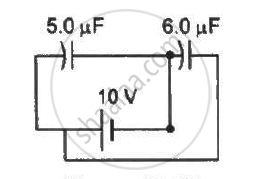
The outer cylinders of two cylindrical capacitors of capacitance 2⋅2 µF each, are kept in contact and the inner cylinders are connected through a wire. A battery of emf 10 V is connected as shown in figure . Find the total charge supplied by the battery to the inner cylinders.

A capacitor is made of a flat plate of area A and a second plate having a stair-like structure as shown in figure . The width of each stair is a and the height is b. Find the capacitance of the assembly.
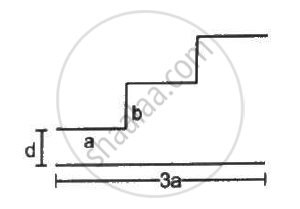
The figure show a network of five capacitors connected to a 10V battery. Calculate the charge acquired by the 5μF capacitor.
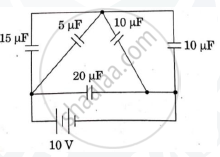
Derive the expression for resultant capacitance, when the capacitor is connected in series.
When air is replaced by a dielectric medium of constant K, the maximum force of attraction between two charges separated by a distance ______.
Two spherical conductors A and B of radii a and b(b > a) are placed concentrically in the air. B is given a charge +Q and A is earthed. The equivalent capacitance of the system is ______.
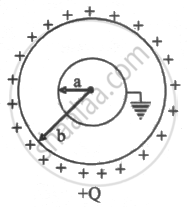
For changing the capacitance of a given parallel plate capacitor, a dielectric material of dielectric constant K is used, which has the same area as the plates of the capacitor.
The thickness of the dielectric slab is `3/4`d, where 'd' is the separation between the plate of the parallel plate capacitor.
The new capacitance (C') in terms of the original capacitance (C0) is given by the following relation:
A parallel plate capacitor (A) of capacitance C is charged by a battery to voltage V. The battery is disconnected and an uncharged capacitor (B) of capacitance 2C is connected across A. Find the ratio of final charges on A and B.
